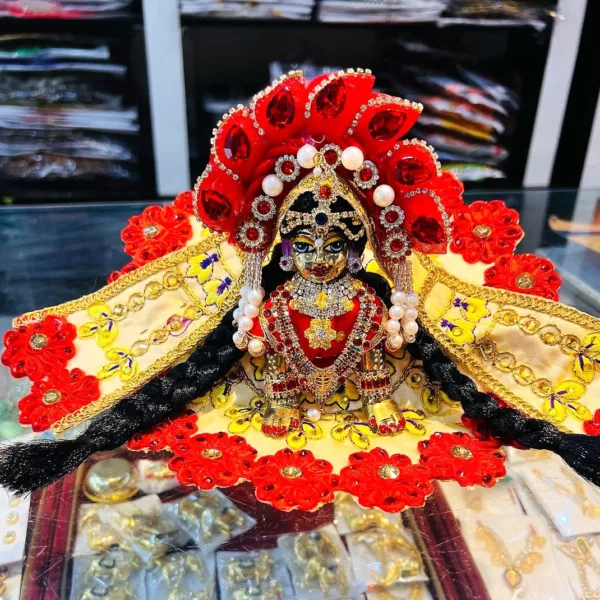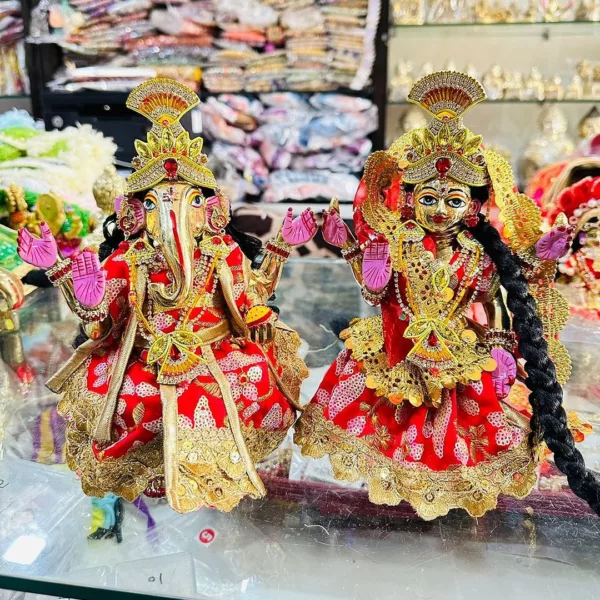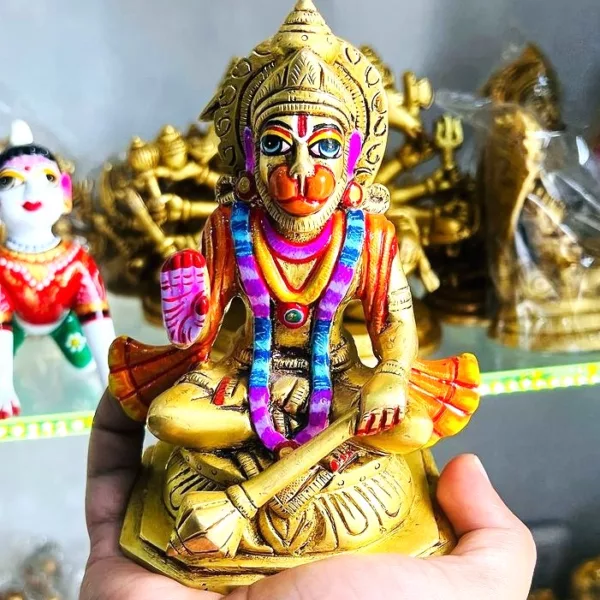Aarti Sangrah Book: Your Essential Guide to Hindu Devotion (55 Aartis, Hindi, Large Print)
Are you seeking a deeper connection to Hindu deities and traditions? This beautifully crafted Aarti Sangrah Book is your indispensable companion. With 55 essential aartis presented in a clear Hindi font and bold, eye-catching red lettering, you’ll find it easier than ever to express your devotion.
Features That Enhance Your Spiritual Journey:
Clarity and Accessibility:
The large, bold print ensures a comfortable reading experience, especially for elders or those with visual difficulties.
- Emphasizes Inclusivity: This highlights how your book caters to a wide audience, including those who might otherwise struggle with smaller fonts.
- Focus on User Experience: It demonstrates that you’ve considered the practical needs of your readers.
- Potential Expansion: You could add a phrase like “…allowing everyone to participate in devotion with ease.”
Perfect for All Occasions:
Whether for daily worship, special festivals, or simply seeking divine blessings, this Aarti Sangrah Book will guide you.
- Versatility: This section positions your book as a constant devotional companion, not just for special events.
- Open-ended Appeal: The phrase “simply seeking divine blessings” broadens the appeal to those at any stage of their spiritual journey.
- Potential Expansion: Consider adding “Enhance your daily puja, celebrate festivals with joy, and find solace in times of need.”
Thoughtful Gifting:
Share the gift of devotion with loved ones. This book is ideal for housewarmings, weddings, religious occasions, or for those new to Hindu practices.
- Generosity: Focuses on the act of giving and the positive intentions behind it.
- Specific Occasions: Gives concrete examples of when your book is an appropriate and meaningful gift.
- Welcoming Newcomers: Acknowledges that your Aarti Sangrah book can be a gateway for those wanting to learn more about Hindu practices.
Inside This Aarti Sangrah Book, You’ll Discover:
Aartis for Major Hindu Deities
Shri Lakshmi Aarti:
Om Jai Lakshmi Mata This aarti is sung in praise of Goddess Lakshmi, the goddess of wealth and prosperity.
Meaning: The aarti expresses devotion to Lakshmi and describes her as the bestower of material abundance, remover of sorrow, and the embodiment of beauty.
Shri Vishnu Aarti:
Om Jai Jagdish Hare A universal aarti dedicated to Lord Vishnu, the preserver of the universe.
Meaning: This aarti praises the various manifestations of Vishnu, his compassion, and seeks his protection for all being
Shri Shiva Aarti:
Om Jai Shiv Omkara Sung in devotion to Lord Shiva, the destroyer and transformer.
Shri Shiva Aarti: Om Jai Shiv Omkara
Meaning: This aarti hails Lord Shiva as the supreme being, with attributes that symbolize his role in the cycle of creation, preservation, and destruction.
Shri Hanuman Aarti
Dedicates to Lord Hanuman, a symbol of strength, devotion, and selfless service.
Meaning: The aarti describes Hanuman’s extraordinary feats and qualities. It seeks his protection, blessings, and strength.
Aartis for Special Festivals
Diwali: Om Jai Lakshmi Mata Goddess Lakshmi is worshippe on Diwali for wealth and prosperity. This aarti is central to Diwali celebrations.
Ganesh Chaturthi: Sukhkarta Dukhharta Aartis to Lord Ganesha are an integral part of Ganesh Chaturthi festivities, invoking his blessings for a smooth and auspicious celebration.
Navratri: Jai Ambe Gauri Dedicate to Goddess Durga in her various forms, this aarti is sung with fervor during the nine days of Navratri.
Meaning: It pays homage to the power of the Divine Feminine, her different forms, and her victory over evil.
Performing Aarti Ritual
Here’s a general guide on how to perform a traditional aarti:
Preparation
- The Thali: Choose a beautiful plate, ideally made of metal like copper, brass, or silver. This is your aarti thali. Thoroughly clean the thali beforehand.
- Diya: Use a traditional earthen or metal diya. Place a cotton wick inside and fill the diya with pure ghee (clarified butter) or oil (sesame or mustard are good options).
- Offerings:
- Flowers: Select fresh, colorful, and fragrant flowers that are pleasing to the deity.
- Incense (Agarbatti): Choose incense with a scent that complements the deity and the overall atmosphere.
- Kumkum: This red/orange/yellow powder, made from turmeric or saffron, is considered auspicious.
- Water: Fill a small, clean vessel with fresh water.
- Other offerings: Include items specific to the deity being worshipped or any special sweets or fruits.
- Assemble the Group: Gather everyone who wishes to participate. Designate one person as the lead for singing the aarti song, and ensure at least one person is available for ringing the bell (optional).
Lighting the Diya
- Place the Offerings: Arrange all the items (diya, flowers, incense, kumkum, water, etc.) neatly on the thali.
- Invocation: Take a moment to focus your thoughts on the deity. Chant a simple invocation mantra or prayer.
- Light the Wick: Gently light the diya’s wick with a match or another small flame. The light from the diya symbolizes the removal of darkness and the presence of the divine.
Performing the Aarti
- Start the Song: The designated person begins singing the aarti song dedicated to the specific deity being worshipped. Everyone else can join in if they know the lyrics.
- Circular Movements: The person holding the aarti thali waves it in gentle, clockwise circles in front of the deity’s image or idol. This movement symbolizes the cycle of life and the light of the deity radiating in all directions.
- Ringing the Bell: If you have a bell, ring it in conjunction with the aarti song.
- Focus and Devotion: While the aarti occurs, everyone should focus their thoughts on the deity with love and devotion.
Offerings
- Completing the Song: Once the aarti song is finished, continue moving the thali in circles for a few extra moments.
- Flower Offering: Gently place a few flowers at the feet of the deity’s image or idol. This symbolizes offering our love and hearts.
- Kumkum: Apply a dot of kumkum to the deity’s idol or image, and then offer kumkum to everyone present to apply to their foreheads.
- Water: Lift the vessel of water and circle it around the deity as a mark of reverence.
Distribution of Prasad
- Blessing the Offerings: The offerings on the thali are now considered “prasad” – food bless by the divine.
- Distribution: Distribute small portions of the prasad to everyone present. This is often done by placing a little into each person’s cupped hands.
- Receiving Prasad: Accept the prasad with reverence, traditionally with your right hand. Consume a small portion as a symbol of partaking of the divine grace.
Embrace the Power of Aarti
Aarti is a central aspect of Hindu worship, a beautiful expression of love, gratitude, and the seeking of divine blessings. Through the offering of light, accompanied by heartfelt prayers and songs, we connect with the divine and cultivate inner peace.
Why Choose This Aarti Sangrah Book?
- Superior Readability: The bold, red lettering on high-quality paper enhances clarity and reduces eye strain.
- User-Friendly Format: The logical organization and clear layout make it easy to find the aarti you need.
- Authentic and Reliable: Our Aarti Sangrah Book is carefully compiled to ensure accuracy and respect for Hindu traditions.
- Durable and Portable: The paperback binding and compact size make this book ideal for both home and travel.
Order Your Aarti Sangrah Book Today and Deepen Your Spiritual Practice






 Dona (प्रसाद दोना)
Dona (प्रसाद दोना)






































Reviews
There are no reviews yet